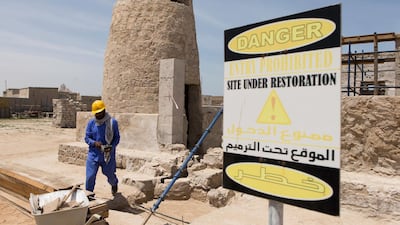In its coverage this week, The National reported on the restoration of Sharjah's historic Bait Al Naboodah, saying that "while the importance and historic values of such structures is being increasingly recognised, it has not always been that way".
These pages noted that many of our old buildings had previously been neglected or have narrowly escaped demolition and argued that we should "preserve and experience" such relics of the past.
There is more to the story than that. There were certainly times when the people of these lands were indeed living in hardship but that was not always applicable to all.
During the heyday in the late 19th century, of the UAE’s 7,000-year-old pearling industry, there was considerable wealth, to which buildings like Bait Al Naboodah testify. Further back, in the early 16th century, merchants from Gujarat were exporting horses from Khor Fakkan to India
At the same time, however, it is true that much of the country’s architectural heritage has disappeared over recent decades.
The bigger castles and forts, by and large, have been preserved and many now perform new functions as museums and heritage centres.
Many other buildings with non-military functions, however, from the homes of prosperous merchants, like Bait Al Naboodah, to Abu Dhabi's historic great mosque, the Mosque of the Otaibas, to more humble homes, have been demolished or have been allowed to fall into disrepair.
Like the castles and forts, these provide evidence of a past that is moving gradually from direct memory into history. They display, for example, the ability of earlier generations to make the best use of the resources available, regardless of hardships, as shown by the fact that these old buildings, depending on location, use a variety of materials, such as mud-bricks, coral blocks or rocks and stones from the mountains.
Over the years, I have watched many such buildings, throughout the Emirates, succumb to the impact of neglect and the passing of time.
_______________
Read more from Peter Hellyer:
Claims that sport is elitist are absurd – just ask any cricketer practising on a sandpit in the UAE
Spare a thought for the elderly and the lonely
Decades on, we are still uncovering the tragic stories of the Second World War
_______________
At the same time, however, the attitude both of the Government and of the public to this important aspect of our heritage has evolved.
Forty years ago, old buildings were something to be removed and replaced, despite the efforts of those who fought for their preservation.
Back in the late 1970s, an expatriate conservationist in Abu Dhabi, passionate to save one building, sat down in protest in front of municipality bulldozers.
She didn’t succeed, being gently and politely removed, but such a scene is unlikely to happen today.
Instead, in Dubai and Sharjah, such buildings are now cherished and restored.
In Ras Al Khaimah, as I heard at a recent archaeological conference, the traditional village of Jazirat Al Hamra, built of coral blocks, is being lovingly recorded and preserved.
In Al Ain, some of the best examples of mud brick houses are being restored while a similar process has taken place in the old village that nestles beneath Fujairah’s fort.
This is all to the good. But there is more that can be done.
How were these structures used? What was the nature of the society of which they formed an integral part? Is enough being done to collect information from those who lived in them?
Is there, too, more that we can learn about the architecture of the buildings? Are there foreign parallels from which we can identify the interchange of cultural influences?
There is, for example, a similarity in style between our circular fortified watchtowers and a late 18th century watchtower design in my home island of Jersey.
The style of the Jersey Martello Towers was derived from a 16th century ancestor built on the island of Corsica by the Italian city-state of Genoa.
A little earlier, the Genoese were actively trading with the Gulf. Was there perhaps an interchange of cultural influence and, if so, which way did it flow?
Perhaps somewhere, in a dusty archive, there may be evidence of that.
The answer to this, and to other questions, is for historians to study. In the meantime, though, we should applaud the preservation of the once-neglected buildings that bear mute witness to our past.
Peter Hellyer is a consultant specialising in the UAE’s history and culture


